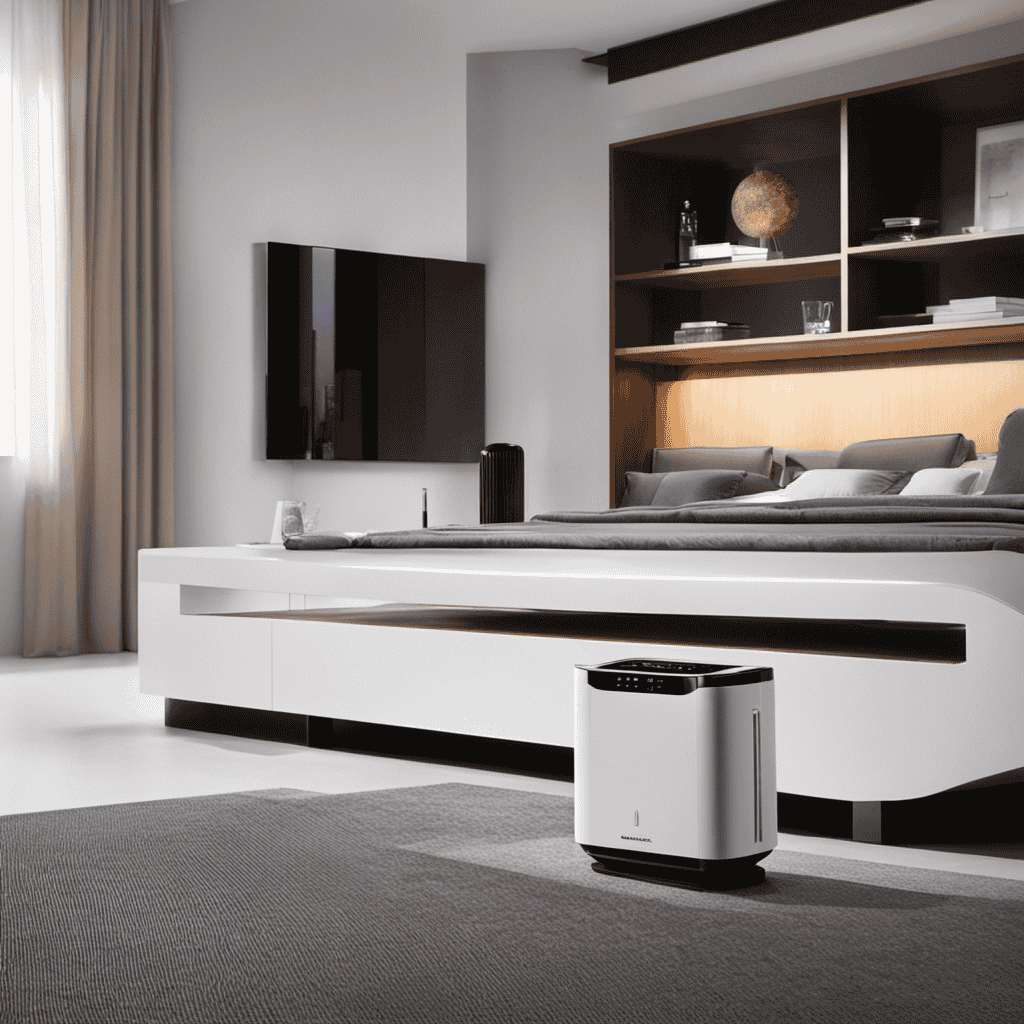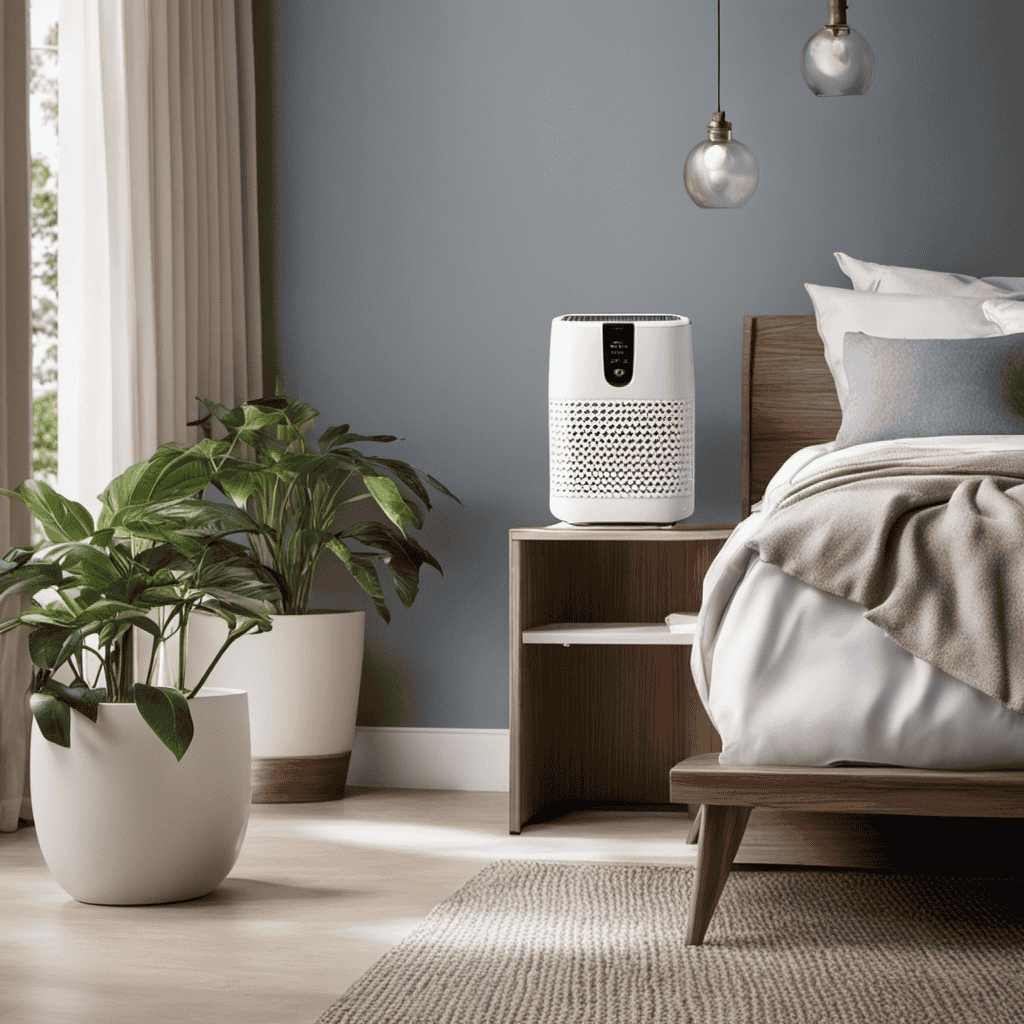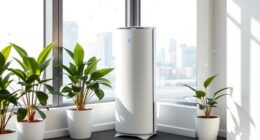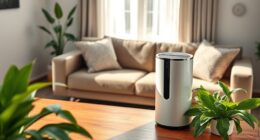I will be discussing air purifiers and delving into their functions.
Did you know that the average person spends about 90% of their time indoors? With that much time spent indoors, the quality of the air we breathe becomes crucial.
Air purifiers play a vital role in improving indoor air quality by removing pollutants and allergens.
In this article, we will delve into the science behind air purifiers, explore their key components, and explain how they effectively eliminate harmful particles from the air.
Key Takeaways
- Air purifiers play a vital role in improving indoor air quality by removing pollutants and allergens.
- They use advanced technology such as HEPA filters, activated carbon filters, and UV-C light to effectively remove particles from the air.
- Components of air purifiers include filters, fans, and pre-filters, which work together to circulate and trap contaminants.
- Choosing the right air purifier involves considering factors such as room size, filtration system, and noise level, and regular maintenance is essential for optimal performance.
The Science Behind Air Purifiers
Now let’s dive into the science behind how an air purifier actually works.
Air purifiers are designed using advanced technology to effectively remove pollutants and improve indoor air quality. These devices work by drawing in the surrounding air and passing it through a series of filters.
These filters are specifically designed to capture and trap various particles such as dust, pollen, pet dander, and even microscopic allergens. The most effective air purifiers use High Efficiency Particulate Air (HEPA) filters, which can remove up to 99.97% of particles as small as 0.3 microns in size.
Some air purifiers also incorporate additional technologies like activated carbon filters or UV-C light to further enhance their effectiveness.
Key Components of an Air Purifier
To understand how an air purifier works, you’ll want to know about its key components.
One of the main components is the filter, which captures and removes particles from the air. Activated carbon filters are commonly used to trap odors and chemicals.
Another crucial component is the fan, which circulates the air through the purifier and helps improve overall air quality.
Some purifiers also include a pre-filter to capture larger particles and prolong the life of the main filter.
It’s important to note that air purifiers require regular maintenance to ensure optimal performance. Cleaning or replacing the filters regularly is essential for efficient operation.
Additionally, it is worth mentioning some common misconceptions about air purifiers, such as the belief that they can eliminate all airborne contaminants or that they can replace proper ventilation.
Understanding the key components and debunking misconceptions will help you make the most of your air purifier and improve the air quality in your space.
How Air Purifiers Remove Pollutants
If you’re wondering how air purifiers remove pollutants, the key lies in their filters and purification processes. Air purifiers are designed to capture and eliminate various airborne contaminants, such as dust, pollen, pet dander, mold spores, and even bacteria. These devices work by pulling in polluted air and passing it through multiple layers of filters. Each filter targets specific pollutants, effectively trapping them and preventing them from recirculating back into the room. The effectiveness of air purifiers in reducing allergies can vary depending on the quality of the filters and the size of the particles they can capture. To give you a better understanding, here’s a table outlining the impact of air purifiers on indoor air quality and their effectiveness in reducing allergies:
| Air Purifier Feature | Impact on Indoor Air Quality | Effectiveness in Reducing Allergies |
|---|---|---|
| HEPA Filters | Highly Effective | Very Effective |
| Activated Carbon | Effective | Moderately Effective |
| UV-C Light | Effective | Moderately Effective |
Benefits of Using an Air Purifier
Imagine how much fresher and cleaner the air in your home could be with the help of an air purifier. Not only does it remove pollutants, but it also offers several benefits that make it a valuable addition to any household.
Here are some reasons why using an air purifier is beneficial:
-
Improved Indoor Air Quality: An air purifier effectively traps and filters out airborne pollutants, such as dust, pollen, pet dander, and mold spores, enhancing the overall air quality in your home.
-
Allergy and Asthma Relief: By removing allergens and irritants from the air, air purifiers can provide relief for those suffering from allergies and asthma, reducing symptoms and improving breathing.
-
Cost Effectiveness: Investing in an air purifier can be cost-effective in the long run. It helps prevent the accumulation of dust and dirt on furniture and electronics, reducing the frequency of cleaning and maintenance.
-
Low Maintenance Requirements: Most air purifiers require minimal maintenance, usually consisting of replacing filters every few months. This makes them convenient and hassle-free to use.
Overall, air purifiers offer a cost-effective solution for improving indoor air quality while requiring minimal maintenance.
Choosing the Right Air Purifier for Your Needs
When choosing the right air purifier for your needs, consider factors such as room size, filtration system, and noise level. A buying guide can help you navigate through the options available in the market and find the best air purifier for your specific requirements. The table below provides a comparison of different air purifiers based on these factors:
| Air Purifier | Room Size Coverage | Filtration System | Noise Level |
|---|---|---|---|
| Model A | Up to 300 sq. ft. | HEPA + Activated Carbon | 40 dB |
| Model B | Up to 500 sq. ft. | HEPA + Ionizer | 50 dB |
| Model C | Up to 800 sq. ft. | HEPA + UV-C Light | 35 dB |
| Model D | Up to 1000 sq. ft. | HEPA + Ozone Generator | 55 dB |
| Model E | Up to 1200 sq. ft. | HEPA + Electrostatic Precipitator | 45 dB |
Maintenance tips for air purifiers include regularly cleaning or replacing the filters, cleaning the exterior surfaces, and following the manufacturer’s instructions for optimal performance. By considering these factors and following proper maintenance, you can ensure that your air purifier effectively removes pollutants and improves the air quality in your space.
Can an Air Purifier Eliminate Pet Dander and Allergens from the Air?
Yes, an air purifier uses and benefits in eliminating pet dander and allergens from the air. By capturing and trapping particles in the air, air purifiers can help reduce allergy symptoms for pet owners. High-efficiency particulate air (HEPA) filters are especially effective at removing pet dander and other allergens.
Frequently Asked Questions
How Often Should I Clean or Replace the Filters in an Air Purifier?
I clean or replace the filters in my air purifier every 3-6 months, depending on the manufacturer’s recommendations and the air quality in my home. This ensures optimal performance and fresh, clean air.
Can an Air Purifier Remove Household Odors, Such as Pet or Cooking Smells?
Yes, an air purifier can effectively remove household odors such as pet or cooking smells. By filtering the air and trapping the odor-causing particles, it helps create a fresher and cleaner environment. The benefits of using an air purifier are numerous.
Are There Any Potential Health Risks Associated With Using an Air Purifier?
There may be potential side effects from using an air purifier, but the long-term effects are not yet fully understood. It is important to consider individual sensitivities and consult with a healthcare professional if concerned.
Can an Air Purifier Help Reduce the Symptoms of Allergies or Asthma?
Yes, an air purifier can help reduce the symptoms of allergies or asthma. It filters out allergens and irritants from the air, like a sieve catching dust. This improves indoor air quality and can alleviate breathing difficulties.
Can an Air Purifier Help Remove Viruses or Bacteria From the Air?
An air purifier can help remove viruses and bacteria from the air. Its effectiveness depends on the specific model and the maintenance of the filters. Regular filter cleaning or replacement is crucial to ensure optimal performance.
Conclusion
After delving into the science behind air purifiers and understanding their key components, it is clear that these devices play a crucial role in removing pollutants from our indoor environments.
The benefits of using an air purifier cannot be understated, as they can help improve air quality and alleviate symptoms of allergies and respiratory issues.
However, it is ironic that while air purifiers strive to create a cleaner and healthier atmosphere, they also rely on electricity, which contributes to environmental pollution.
Nonetheless, choosing the right air purifier can make a significant difference in maintaining a breathable and purified living space.










